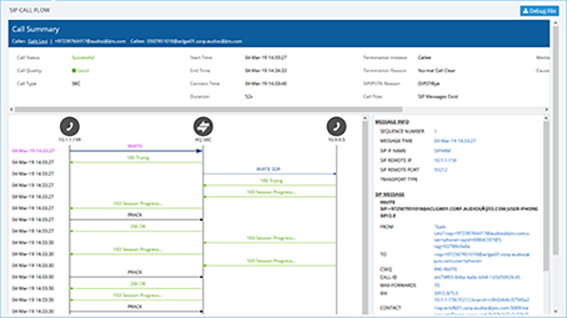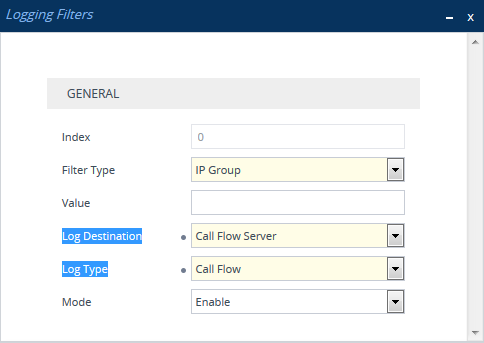Enabling SIP Call Flow Diagrams in OVOC
You can configure the device to send SIP messages (in XML format) of SIP call dialogs to AudioCodes One Voice Operations Centers (OVOC) so that OVOC management users can view the call dialog as a call flow diagram. OVOC displays the call flow using vertical and horizontal lines where the vertical lines represent the SIP entities (including the device itself) involved in the dialog and where the horizontal lines represent the SIP requests and responses. An example of a SIP call flow diagram in OVOC is shown below.

SIP call flow diagrams may be useful for debugging and for better understanding of the SIP call. The call flow displays all the SIP messages related to the call session, including requests (e.g., INVITEs) and responses (e.g., 200 OK). For SBC calls, the call flow reflects messages as sent "over the wire" - incoming messages before manipulation and outgoing messages after manipulation. For Gateway calls, the call flow reflects incoming messages after Pre-Parsing Manipulation (if configured) but before general Message Manipulation, and outgoing messages after manipulation.
|
➢
|
To configure SIP call flow support: |
|
1.
|
Enable the OVOC call flow feature: |
|
a.
|
Open the Logging Settings page (Troubleshoot menu > Troubleshoot tab > Logging folder > Logging Settings). |
|
b.
|
From the 'Call Flow Report Mode' [CallFlowReportMode] drop-down list, select Enable. |

|
2.
|
To send call flow messages of specific calls only (e.g., for a specific IP Group), configure a Log Filter rule: |
|
b.
|
Click New , and then configure the rule as desired, but with the following parameter settings: |
|
◆
|
'Log Destination': Call Flow Server |

|
●
|
If you have not configured any filtering rule for SIP call flow in the Logging Filters table, the device sends call flow messages to OVOC for all calls. |
|
●
|
The device does not send OVOC SIP messages that fail authentication (SIP 4xx challenge). |
|
●
|
The feature does not support REGISTER messages. |
|
●
|
If the device experiences a CPU overload, it stops sending SIP call flow messages to OVOC until the CPU returns to normal levels. |


